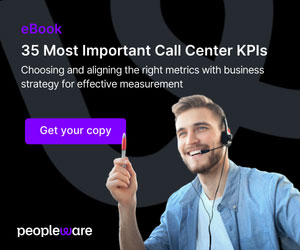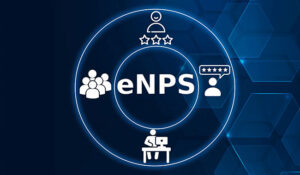Darren Deehan at Peopleware explores eNPS, how to avoid a major pitfall, and how to get higher eNPS scores by applying best practices in Workforce Management (WFM).
Net Promoter Score (NPS) is a measure of customer satisfaction. It first appeared in the 2003 Harvard Business Review article, The One Number You Need to Grow.
Employee Net Promoter Score (eNPS) was derived from NPS. It is a measure of employee satisfaction, and just like NPS, it asks one simple question: “On a scale from zero to ten, how likely is it that you would recommend our company as a place of work to a friend or acquaintance?”
Why Should You Measure eNPS?
Employee Net Promoter Score (eNPS) was invented by a tech startup in San Francisco that was struggling to hire and retain top talent. They wanted to be able to detect low employee morale and do something about it before it became such a problem that people started leaving.
Does that sound familiar? According to ContactBabel, average annual contact centre staff turnover was historically 20%, but since Covid-19 and the Great Resignation, that number has increased.
McKinsey & Company reports that the average cost of a new agent hire is $10,000-$20,000. A well-known maxim is “happy employees make happy customers and happy customers grow your business”.
So monitoring eNPS and taking action to improve call centre agent engagement isn’t altruistic. It contributes significantly to the business’s bottom line.
How Do You Measure eNPS?
The calculation of the eNPS score is simple:
eNPS = Promoters (%) – Detractors (%)
The lowest possible eNPS score is −100 (i.e., everybody is a detractor), and the highest is +100 (everybody is a promoter).
According to a SmartSurvey, any score above zero can be considered acceptable, while a score of between 10 and 30 is perceived as good. Above 50 is excellent. If the eNPS is below zero, it’s time to take action to improve agent satisfaction.
Tip: How to Measure eNPS in Your Contact Centre
Several online survey platforms can be used to measure eNPS. However, you can also use programs such as “Google Forms” or “Microsoft Forms”, which are often included in company software packages. They can all be used to send (e)NPS surveys to customers and employees.
It’s important to note a key difference between these surveys: NPS surveys are usually not anonymous, as it is common in the customer world to ask for contact details and email addresses.
This allows you to help dissatisfied customers and reward fans of your company or ask them to recommend your product on social media.
In contrast, most companies prefer to conduct their eNPS surveys anonymously. The reasoning is clear: when identities remain confidential, employees are more likely to provide honest feedback, highlight challenges, and address concerns.
In highly hierarchical organizations in particular, employees are afraid of the consequences if management learns that they see problems.
That said, choosing not to conduct these surveys anonymously can be beneficial – especially in organizations with a strong feedback culture, open communication and a psychologically safe environment.
We tested this at Peopleware and have been sending our monthly eNPS survey to all employees on a non-anonymous basis.
The great advantage of this is that you can conduct targeted follow-up discussions that provide valuable insights and help to derive concrete measures to improve employee satisfaction.
However, this only works if you hold regular 1-on-1 discussions with employees and maintain an open relationship in which the exchange of opinions is valued and never punished.
Each company must determine which survey format aligns best with its culture and goals. A conscious decision for or against anonymity can have a big impact on how effectively the opportunity to provide honest feedback is used.
Ultimately, the goal should be to create an environment where employees feel safe to share their opinions, regardless of whether this is done anonymously or not.
How WFM Improves eNPS
The original goal of workforce management (WFM) was to deliver on customer service goals at minimum cost with little regard for call centre agent engagement.
Today, well-run contact centres strive to optimize the balance between the needs of the customer, the needs of the employee, and the needs of the business. And today’s WFM software applications are built to enable you to do just that.
The Importance of Flexibility
Call centre employees increasingly expect to work shifts that fit around their personal lives. In fact, flexible working from the first day of employment is likely to become a legal requirement in the UK before long.
Employers which don’t provide this option will face lower eNPS scores and higher staff turnover. Conceding to every flexible working request is a recipe for disaster.
But WFM applications make it possible to balance the desires of the employees with the requirements of the business.
For example:
- Enabling employee-led scheduling with techniques like shift bidding and availability setting
- Giving agents greater visibility of their work schedule in advance
- Allowing agents to swap shifts with their colleagues without the interference of a ‘manager’
- Permitting agents to manage their own time off
- Giving agents visibility into when their teammates go for breaks
Other Ways That WFM Has a Positive Effect on eNPS
- Good forecasting practice can help reduce stress and burnout by accurately forecasting workload, then matching supply with demand
- Deliberately applying reasonable occupancy rates when calculating staffing requirements helps minimize burnout
- Real-time management enables you to quickly identify periods of understaffing and take informed corrective action before it stresses your agents – and customers
- Agents love self-service shift-bidding, shift swapping, and time off booking using their smartphones or mobile devices
The Business Impact of Growing eNPS in the Call Centre
62% of Call Centre Helper readers view employee satisfaction as a “very important metric”. The Gallup workplace survey reports that when measuring employee engagement, top- and bottom-quartile businesses had the following differences in business outcomes:
- 81% reduction in absenteeism
- 18% reduction in turnover for high staff churn organizations (43% for low churn organizations)
- 41% increase in quality
- 10% increase in customer loyalty
- 23% increase in profitability
Conclusion
The key takeaways from this article are:
- Agent satisfaction has a big effect on contact centre performance and customer experience
- eNPS is a powerful metric for tracking, analysing, and growing agent satisfaction
- Each company must decide for itself whether the eNPS survey is to be conducted anonymously or non-anonymously
- WFM software provides multiple ways to address the underlying reasons for poor eNPS and to drive it upwards
This blog post has been re-published by kind permission of Peopleware – View the Original Article
For more information about Peopleware - visit the Peopleware Website
Call Centre Helper is not responsible for the content of these guest blog posts. The opinions expressed in this article are those of the author, and do not necessarily reflect those of Call Centre Helper.
Author: Peopleware
Reviewed by: Jo Robinson
Published On: 8th Apr 2025
Read more about - Guest Blogs, Peopleware






 Peopleware is the award-winning, multi-channel cloud workforce management application for contact centers and customer support. Over 300 customers, ranging in size from 50 to over 4,000 seats, trust Peopleware to bring work and demand in perfect balance while embracing the constant change in their business. With Peopleware, you spend less time and effort on manual forecasting and scheduling, while maximizing efficiency and focusing on what really matters: your people and customers.
Peopleware is the award-winning, multi-channel cloud workforce management application for contact centers and customer support. Over 300 customers, ranging in size from 50 to over 4,000 seats, trust Peopleware to bring work and demand in perfect balance while embracing the constant change in their business. With Peopleware, you spend less time and effort on manual forecasting and scheduling, while maximizing efficiency and focusing on what really matters: your people and customers.









